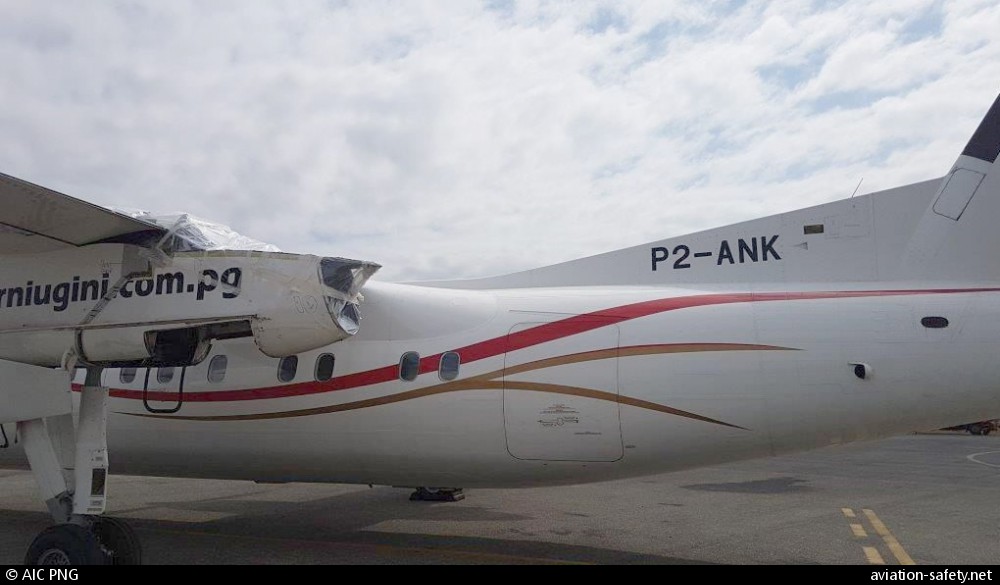
| Date: | Friday 4 August 2017 |
| Time: | 09:22 |
| Type: |  de Havilland Canada DHC-8-202Q Dash 8 |
| Owner/operator: | LinkPNG |
| Registration: | P2-ANK |
| MSN: | 461 |
| Year of manufacture: | 1997 |
| Total airframe hrs: | 36000 hours |
| Engine model: | Pratt & Whitney Canada PW123D |
| Fatalities: | Fatalities: 0 / Occupants: 31 |
| Aircraft damage: | Minor, repaired |
| Category: | Accident |
| Location: | 72 km NW of Port Moresby -
 Papua New Guinea Papua New Guinea
|
| Phase: | En route |
| Nature: | Passenger - Scheduled |
| Departure airport: | Port Moresby-Jacksons International Airport (POM/AYPY) |
| Tari Airport (TIZ/AYTA) | |
| Investigating agency: | AIC PNG |
| Confidence Rating: |
The DHC-8-202 aircraft, registration P2-ANK, owned by Air Niugini and operated by LinkPNG, completed flight 713 from Bulolo to Port Moresby in Papua New Guinea. According to the Technical Log, the aircraft was serviceable when it arrived at Port Moresby at 07:31 hours.
The aircraft was scheduled for flight PX864, from Port Moresby to Tari on the same day. The pilots carried out a normal pre-flight inspection of the aircraft before it was released to service by the licensed engineer on duty. After obtaining a clearance from air traffic control (ATC), P2-ANK departed from runway 14L at 09:04, then made a right turn, and commenced tracking on the 298°R of the Port Moresby VOR for Tari, under IFR procedures. There were 28 passengers, two pilots, and one flight attendant on board. At about 09:20 while 39 nm west-northwest of Port Moresby and passing 20,000 ft during the climb, both pilots heard a bang sound, and felt the aircraft shudder.
The copilot reported that he first thought that it was an engine failure. However, visual checks of the engines and instrument gauges showed that both engines were operating normally. He then did a further quick scan of the instrument panel and said that he saw the "unsafe left hand main landing gear door indication" amber light illuminated. He said that he immediately advised the pilot in command (PIC). The copilot then informed ATC of their intention to return to Port Moresby, and that a normal approach and landing was expected.
The flight attendant then alerted both pilots that the left main landing gear door was open. That confirmed the reason for the illuminated left main landing gear door OPEN Advisory light. The PIC referred to the Quick Reference Handbook (QRH) as a precaution, and descended to remain below 15,000 ft, and not above 130 knots.
At 10 nm from Port Moresby, the copilot requested clearance from ATC to track west of Port Moresby to the Daugo Island area, to hold for 30-40 minutes and burn-off fuel, due to the maximum allowable landing weight.
After burning off the excess fuel to achieve a landing weight of 15,650 kgs, they requested a clearance from ATC to continue descent to Jacksons for a landing.
After obtaining a clearance to land the copilot selected the landing gear down. With the landing gear fully extended, the cockpit indication was three green lights illuminated. The copilot conducted a cross-check against the alternate landing gear selection, which showed three green lights illuminated. They proceed to land, assured that the nose- and main- landing gear were safe. At 10:46, the aircraft landed on runway 14L, and was cleared to cross runway 14R to the parking area.
The PIC reported that it was at that moment they realized that everyone on the tarmac was looking at the aircraft, particularly the left side. It wasnt until the passengers and the crew disembarked, that the crew were advised by the engineers that panels were missing aft of the left exhaust nacelle.
Further inspection found that the left main landing gear number-two tyre was deflated and damaged. It was apparent that when the tyre blew out in the wheel well, it caused substantial damage to the main structure on the inside of the nacelle. It was then the crew realised that the bang sound they heard was the tyre exploding in flight at 20,000 ft.
It is likely that the FOD damage occurred when a jagged rock impacted the non-serial sidewall of the number two tyre during the landing at Bulolo on 3 August 2017. The aircraft returned to Jacksons safely, but the damage was not found during post-and pre-flight inspections. During the subsequent flight after departure from Jacksons on 4 August, the casing plies in the impacted area fractured, propagating from the serial side sidewall along the cord direction to tread area and the non-serial side sidewall. It is likely that the significantly damaged and weakened casing of the tyre, and the differential of the atmospheric pressure compared with the pressure within the tyre, caused the tyre to blow out, resulting in substantial damage to the left nacelle.
Accident investigation:
 |
|
Sources:
History of this aircraft
Other occurrences involving this aircraft
| 20 November 2019 | P2-ANK | Air Niugini (Link PNG) | 0 | Mount Hagen Airport, Western Highlands |  |
non |
| Engine failure | ||||||
Location
Images:

photo (c) AIC PNG; Port Moresby-Jacksons International Airport (POM/AYPY); 04 August 2017
Revision history:
| Date/time | Contributor | Updates |
|---|
The Aviation Safety Network is an exclusive service provided by:


 ©2024 Flight Safety Foundation
©2024 Flight Safety Foundation